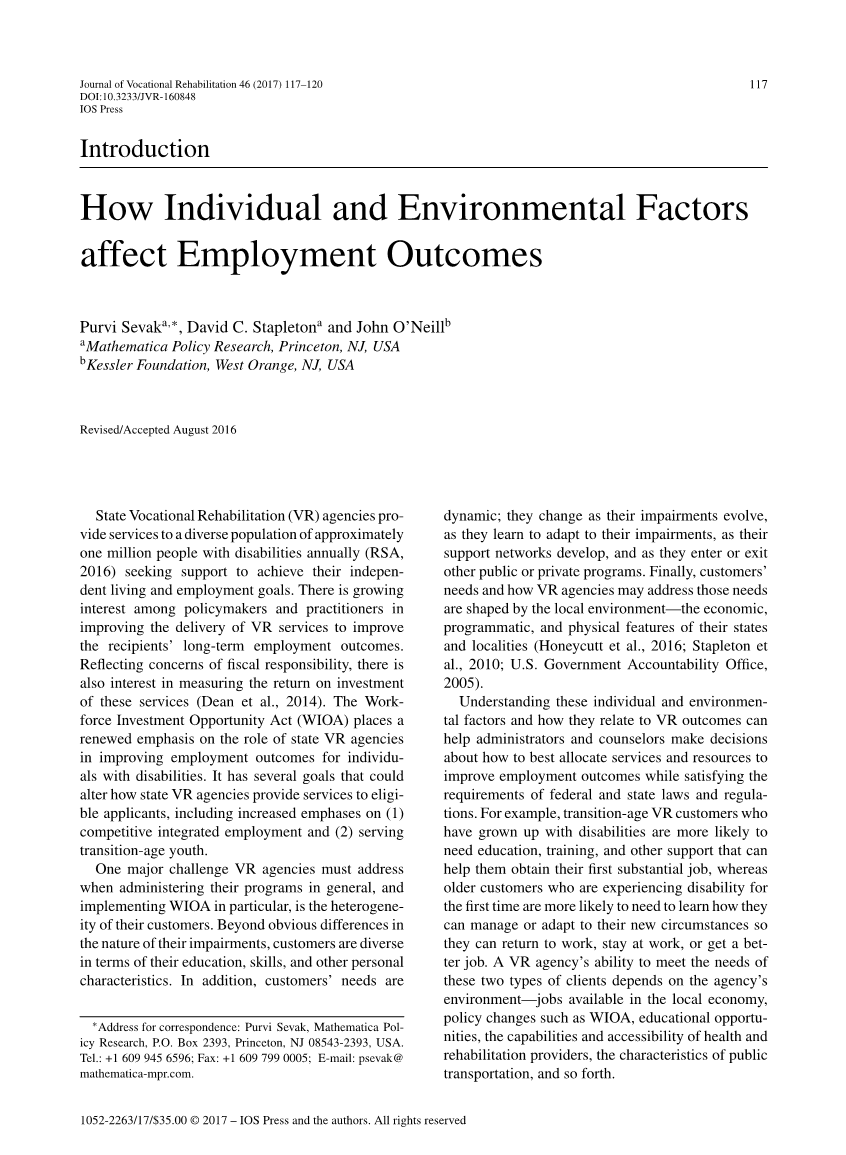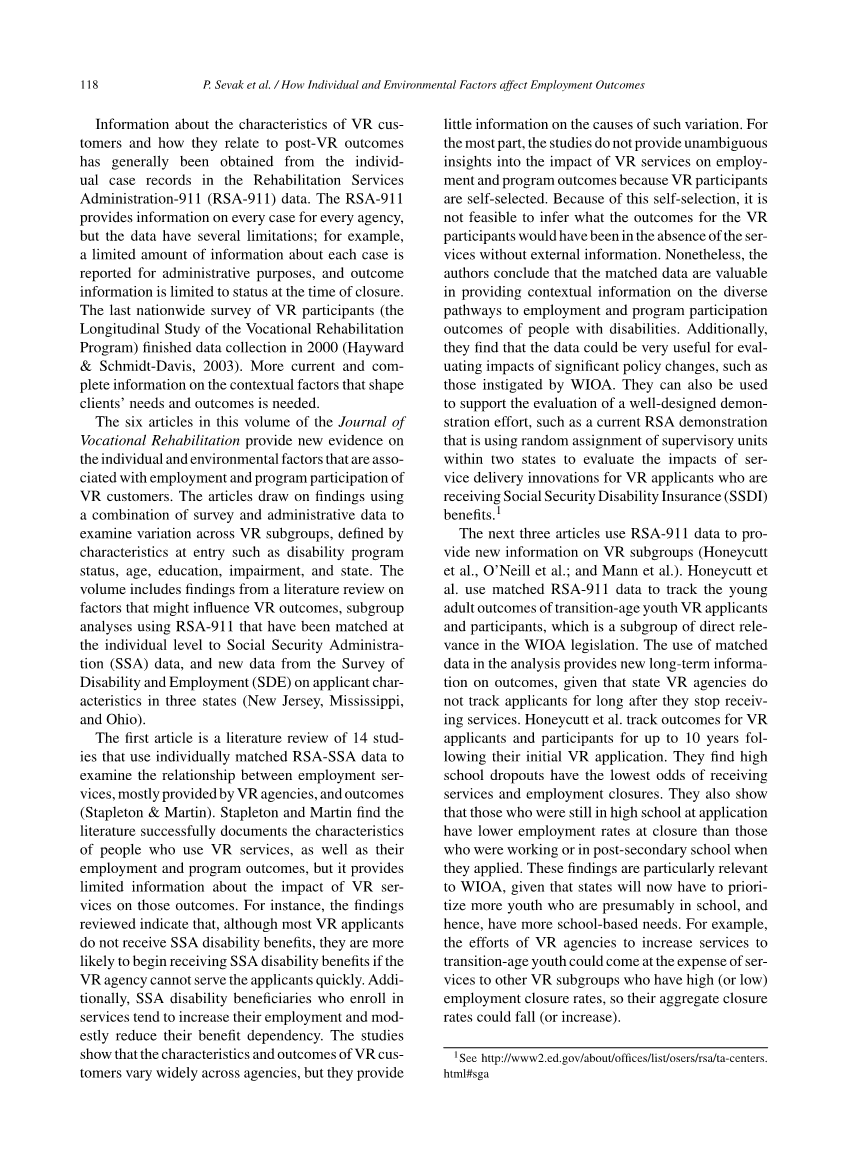

英语原文共 4 页,剩余内容已隐藏,支付完成后下载完整资料
个人和环境因素如何影响就业结果
目 录
英文原文
How Individual and Environmental Factors affect Employment Outcomes(节选)
State Vocational Rehabilitation (VR) agencies provide services to a diverse population of approximatelyone million people with disabilities annually (RSA,2016) seeking support to achieve their independent living and employment goals. There is growing interest among policymakers and practitioners in improving the delivery of VR services to improve the recipientsrsquo;long-term employment outcomes. Reflecting concerns of fiscal responsibility, there is also interest in measuring the return on investment of these services (Dean et al., 2014). The Workforce Investment Opportunity Act (WIOA) places a renewed emphasis on the role of state VR agencies in improving employment outcomes for individuals with disabilities. It has several goals that could alter how state VR agencies provide services to eligible applicants, including increased emphases on (1) competitive integrated employment and (2) serving transition-age youth.
One major challenge VR agencies must address when administering their programs in general, and implementing WIOA in particular, is the heterogeneity of their customers. Beyond obvious differences in the nature of their impairments, customers are diverse in terms of their education, skills, and other personal characteristics. In addition, customersrsquo; needs are dynamic; they change as their impairments evolve, as they learn to adapt to their impairments, as their support networks develop, and as they enter or exit other public or private programs. Finally, customersrsquo; needs and how VR agencies may address those needs are shaped by the local environment—the economic, programmatic, and physical features of their states and localities (Honeycutt et al., 2016; Stapleton et al., 2010; U.S. Government Accountability Office, 2005).
Understanding these individual and environmental factors and how they relate to VR outcomes can help administrators and counselors make decisions about how to best allocate services and resources to improve employment outcomes while satisfying the requirements of federal and state laws and regulations. For example, transition-age VR customers who have grown up with disabilities are more likely to need education, training, and other support that can help them obtain their first substantial job, whereas older customers who are experiencing disability for the first time are more likely to need to learn how they can manage or adapt to their new circumstances so they can return to work, stay at work, or get a better job. A VR agencyrsquo;s ability to meet the needs of these two types of clients depends on the agencyrsquo;s environment—jobs available in the local economy, policy changes such as WIOA, educational opportunities, the capabilities and accessibility of health and rehabilitation providers, the characteristics of public transportation, and so forth.
Information about the characteristics of VR customers and how they relate to post-VR outcomes has generally been obtained from the individual case records in the Rehabilitation Services Administration-911 (RSA-911) data. The RSA-911 provides information on every case for every agency, but the data have several limitations; for example, a limited amount of information about each case is reported for administrative purposes, and outcome information is limited to status at the time of closure. The last nationwide survey of VR participants (the Longitudinal Study of the Vocational Rehabilitation Program) finished data collection in 2000 (Hayward amp; Schmidt-Davis, 2003). More current and complete information on the contextual factors that shape clientsrsquo; needs and outcomes is needed.
The six articles in this volume of the Journal of Vocational Rehabilitation provide new evidence on the individual and environmental factors that are associated with employment and program participation of VR customers. The articles draw on findings using a combination of survey and administrative data to examine variation across VR subgroups, defined by characteristics at entry such as disability program status, age, education, impairment, and state. The volume includes findings from a literature review on factors that might influence VR outcomes, subgroup analyses using RSA-911 that have been matched at the individual level to Social Security Administration (SSA) data, and new data from the Survey of Disability and Employment (SDE) on applicant characteristics in three states (New Jersey, Mississippi, and Ohio).
The first article is a literature review of 14 studies that use individually matched RSA-SSA data to examine the relationship between employment services, mostly provided by VR agencies, and outcomes (Stapleton amp; Martin). Stapleton and Martin find the literature successfully documents the characteristics of people who use VR services, as well as their employment and program outcomes, but it provides limited information about the impact of VR services on those outcomes. For instance, the findings reviewed indicate that, although most VR applicants do not receive SSA disability benefits, they are more likely to begin receiving SSA disability benefits if the VR agency cannot serve the applicants quickly. Additionally, SSA disability beneficiaries who enroll i
剩余内容已隐藏,支付完成后下载完整资料
资料编号:[267221],资料为PDF文档或Word文档,PDF文档可免费转换为Word


